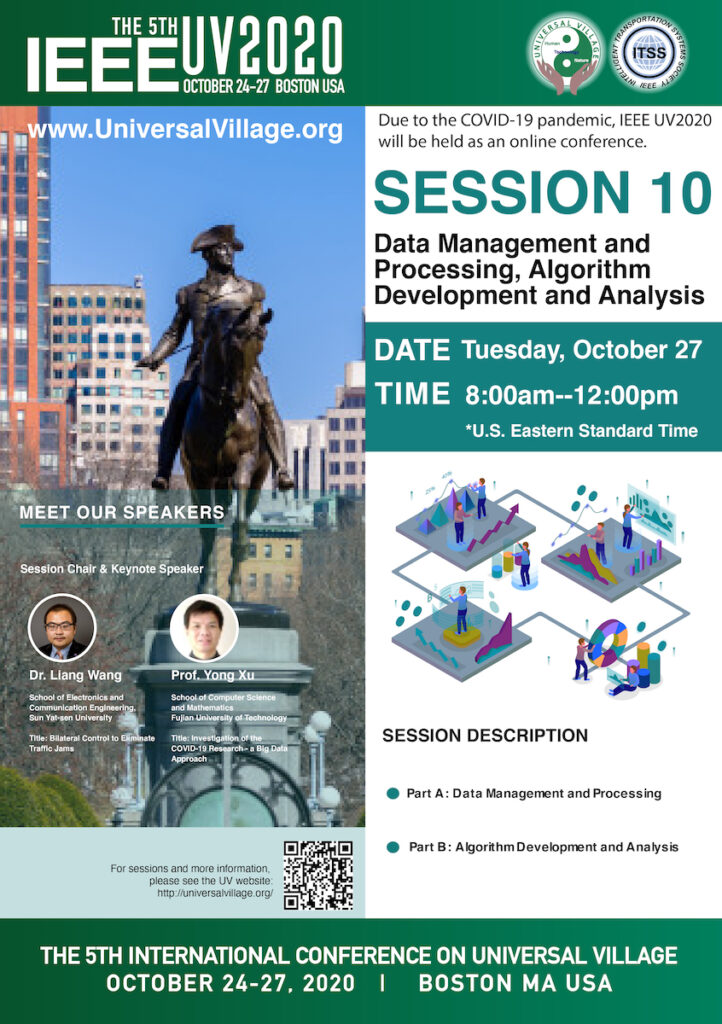Tuesday, October 27 | 8:00 am – 12 pm (U.S. Eastern Time)

Professor Liang Wang is currently an Associate Professor of Electronics and Communication Engineering with Sun Yat-sen University. His research interests include autonomous vehicles, machine vision, smart sensing, and control. He was a Postdoctoral Research Scholar with the Computer Science and Artificial Intelligence Laboratory, Massachusetts Institute of Technology from January 2015 to December 2018. Professor Liang Wang received his Ph.D. degree in computer application technology from the School of Computer and Information Technology, Beijing Jiaotong University, China in in 2015 and was a visiting Ph.D. student in the Mathematics Department, Massachusetts Institute of Technology, from 2011 to 2013. He received his B.S. and M.S. degrees in electronic engineering in 2006 and 2008, respectively, from the School of Electronic and Information Engineering, Beijing Jiaotong University, China. He won the Best Paper Award from International Conf. on Intelligent Transportation System. Professor Wang holds patents innovating the mask manufacturing line to fight Covid19, and published the Chinese translation of “Machine Vision,” the classical textbook used by MIT written by Professor Berthold K. P. Horn, the founding father of Machine Vision field.
Speech Title: Bilateral Control to Eliminate Traffic Jams
Speech Abstract: Bilateral control can suppress traffic flow instabilities. The simplest form of bilateral control uses information about the relative positions and relative velocities of leading and trailing vehicles. In this paper, we provide a multi-node version of bilateral control, in which information about the state of more than just the immediately leading and trailing cars is used. In this mode of control, the question arises: “How much weight should information about vehicles at different positions be given?” Two different methods — a Taylor series approach and a least squares approach — are explored. We show that the least squares approach generates sets of coefficients that can damp out low-frequency components of perturbations faster. This means that traffic under multi-node bilateral control will approach an equilibrium state more rapidly than under the traditional version of bilateral control. Simulation results confirm our analysis.

School of Computer Science and Mathematics, Fujian University of Technology
Speech Title: Investigation of the COVID-19 Research – a Big Data Approach
Abstract: The current novel coronavirus disease in 2019 (COVID-19) has plagued human beings for more than 10 months as a great global threat to public health. To tackle this, researchers have been taking whatever measures they can to try to find the facts, truth and causes of this disease in the hope of preventing its spread and saving the patients’ life. Technological or comprehensive reviews were also conducted in an effort to summarize the observations and findings. This paper started with the download of 16,560 publications from Web of Science and employed the big data method, a totally different point of view, to reveal the unknown facts concealed in these publications by identifying some of the most frequently mentioned key words in the abstracts. Then they were classified into seven different aspects, including the basic information, time and countries, people group, symptoms, complications, diagnostic methods and research methods for analyses. Our findings showed that this simple method proves itself as being applicable in bringing to light some unknown facts or factors hidden behind the haphazard research data and that our results are consistent with the facts revealed in traditional statistic methods.
Index Terms: SARS-CoV-2, nCoV19, Bigdata, Artificial Intelligence, Machine Learning
-
- Data cleaning; data fusion and integration; data quality and integrity; data visualization; data mining; big data analytics
- Human-centered/cognitive/mobile/cloud computing
- Urban informatics; data-driven monitoring, analysis, prediction, planning and decision making; real-time big data services; smart city control centers; application benchmarking and city indices; knowledge management (KM)
-
- Signal processing and understanding (image/video/audio/speech/natural language); semantics interpretation; multimodal sensor fusion and city monitoring; diagnostic algorithms
- AI, machine learning and interpretability; fairness, accountability, privacy, transparency, and ethics; deep-fake detection
- Intelligent modeling, simulation, prediction and optimization; system dynamics; system control



